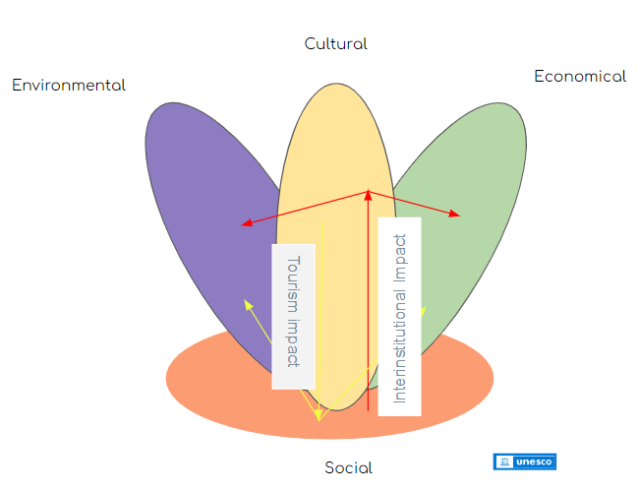According to the definition adopted by the UNWTO General Assembly, at its 22nd session (2017), Cultural Tourism implies “A type of tourism activity in which the visitor’s essential motivation is to learn, discover, experience and consume the tangible and intangible cultural attractions/products in a tourism destination. These attractions/products relate to a set of distinctive material, intellectual, spiritual and emotional features of a society that encompasses arts and architecture, historical and cultural heritage, culinary heritage, literature, music, creative industries and the living cultures with their lifestyles, value systems, beliefs and traditions”.
Cultural resources and destinations receive a growing number of visitors, having entered in the circuits of mass tourism. Cultural heritage, both tangible and intangible, have been incorporated into the tourist offer and competitiveness among destinations, since they attract specific segments of demand and foster new practices and experiences. In order to configure sustainable cultural tourism in destinations, beyond scientific will and social commitment, effective cooperation mechanisms are needed between the sectors and agents involved, as well as active and responsible heritage management, essential for its conservation, something that, if although it has been claimed in international letters and summits, it is proving very difficult.
Cultural tourism requires cultural-historical-artistic resources for its development. It is more demanding and less seasonal.
– Urban: developed in cities, mainly those that are World Heritage Sites. Clients of cultural level and high purchasing power.
– Monumental: linked exclusively to historical-artistic monuments that may be far from major population centers.
– Archaeological: linked to archaeological sites and sites that may be far from major population centers.
– Funeral: linked to cemeteries where there are either tombs made by famous architects or famous people are buried there.
– Ethnographic: linked to the customs and traditions of the peoples. In some cases close to ecological tourism.
– Literary: motivated by bibliographic places or events.
– Training: linked to studies, mainly languages.
– Scientific: it is a tourist offer to carry out research in special places such as biological stations or archaeological sites.
– Gastronomic: linked to the traditional food of a place.
– Oenological: linked to the wines of an area.
– Industrial: motivated by visits to factories or large civil constructions.
– Itinerant: it takes place in several places following pre-established routes.

Ruštule, Desert from Paštrovići, Budva. Montenegro
The effective management of cultural resources requires their full and active incorporation into territorial development, facing the not easy challenge of incorporating tourism into the cause of conservation and sustainable development. This is something very difficult in the time of ultra-liberalism when the ruling classes and many political leaders think that planning is not necessary or trivialize it, just when at a technical and scientific level it is evident that every day it is more necessary to implement on the verge of better planning and more efficient management, adapted to the reception capacity of the different resources and destinations.
The success of a cultural destination and the possibilities of controlling tourist pressure, where the reception capacity is limited, depends more on the political and technical will to coordinate actions of a diverse nature than on the explicit formulation of tourism or cultural policies. given that sectoral policies are not usually very effective when applied to cross-cutting fields such as tourism and culture.
This is very important time for cultural tourism in Montenegro and we have to use the best practeces from EU and also to use their mistakes, to learn and not repeat them here and now. If our state and local managemnt have will we can use all the knowledge and research from similar Mediteranean countries and make our cultural tourism our main destination competitiveness.
Here is one great example I like to use to show the importannce of cultural tourism in destination sustainability:

Lotus flower model, UNESCO.org
The first dimension for sustainability is the most important and that would be the Social dimension, shown as the roots of the flower. The second part of the flower is the Cultural dimension, seen as the pillar of the flower. And the petals of the flower are formed as a consequence of the Environmental dimension and also the Economical one. So, the idea of the model is having two different impacts inside the model / destination. The first one is the impact caused by the tourists, so when the tourist visits the flower, he/she will arrive in the first part of the flower and he sees the cultural elements (yellow arrow). By getting to the destination he will be spread the consequences for the society, and then, this consequence will be spread by environmental and economical petals, dimensions of the model. And the second impact we have is the manager vision of the model – institutional impact. Why? Because it starts in the Social dimension, the rooths. The reason for this is that you have a cultural resource, element, site only if the society validates it. It is a rule. You do not have cultural monument if the society did not validate it first. So the manager vision starts in the roots, in the social dimension (shown with red arrow), and when the cultural element is validated and created, then it goes to Cultural dimension and then we have the impact spread to Environmental and Economical dimensions inside the model.
Cultural element is not the most important one for sustainability, it is the Social one, but it is a pillar – a very important part of the sustainability.
Author: Marija Lazarevic, MSc
CEO and Executive consultant
MariXperience LTD
Sources:
- https://www.unwto.org
- www.unesco.org
- Troitiño Vinuesa, M. A., & Troitiño Torralba, L. (2018). Visión territorial del patrimonio y sostenibilidad del turismo. Boletín de la Asociación de Geógrafos Españoles, 78, 212–244.

